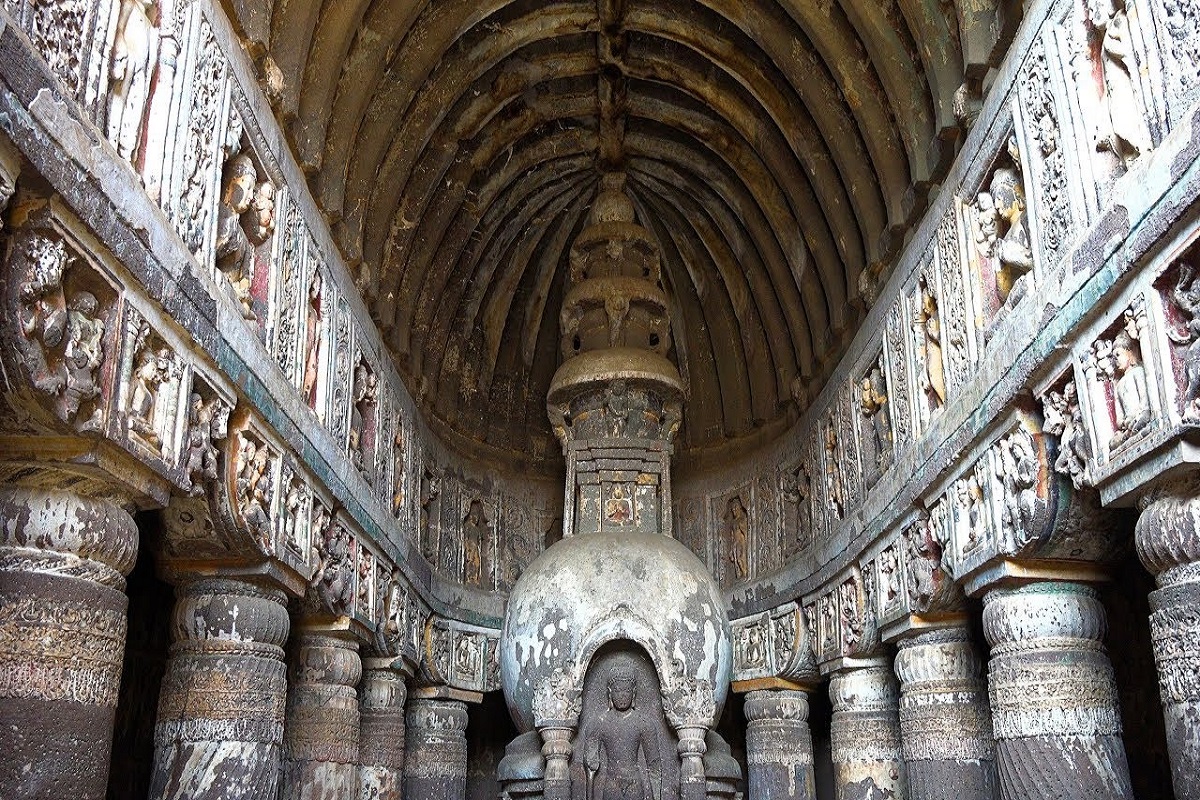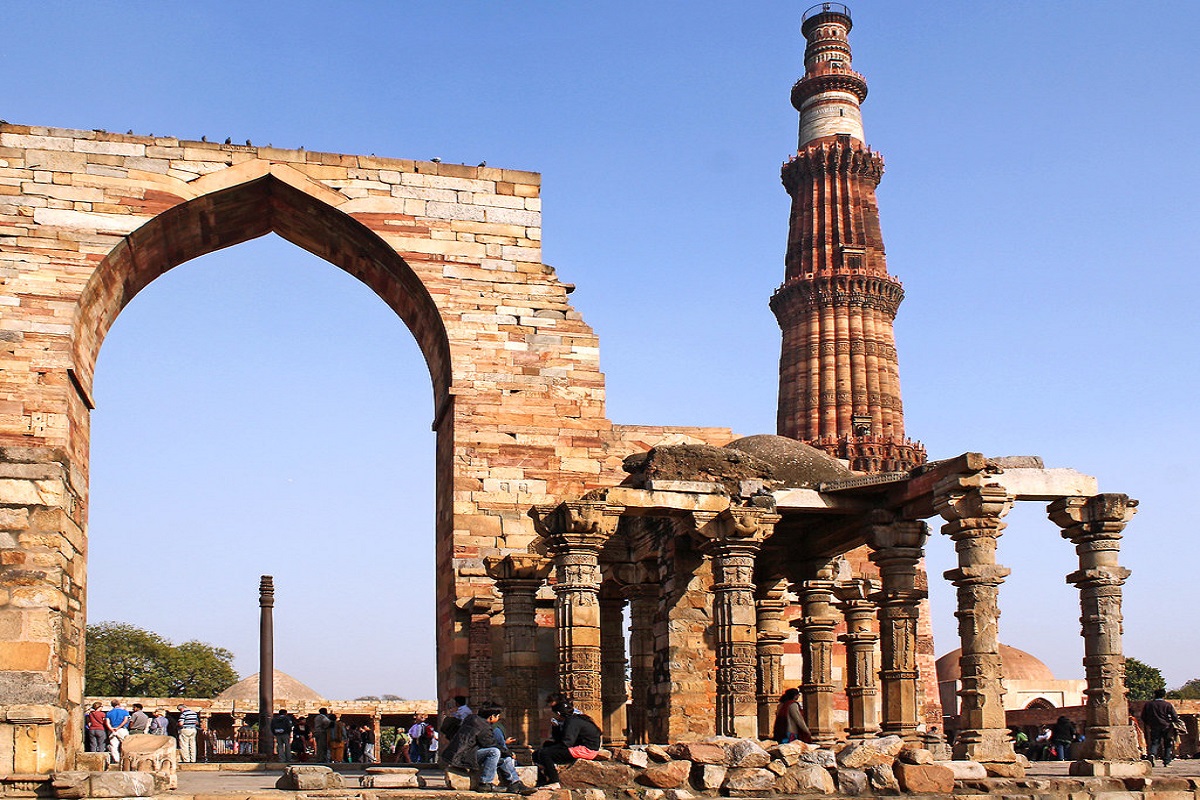The Ajanta Caves is located near the medieval village of Ajanta in Aurangabad in Maharashtra. The village is at a distance of 107 kilometers from the main city of Aurangabad and is at 60 kms from Jalgaon. Here you can find a cluster of 32 caves, which happens to be one of the major specimens of Indian art and culture. These Buddhist caves are a protected site under the authority of ASI and have been declared as one of the UNESCO World Heritage Sites.
The Ajanta Caves are renowned for their paintings and wall sculptures. These paintings depict various Buddhist themes and exhibits tales from the life of Lord Buddha, and his previous mortal lives on the earth.
Ajanta Caves Built By
The Ajanta Caves approximately contains about 30 rocket came that are styled in the form of Buddhist monuments the date of these caves are spread across the course of history. Some of them they back to the 2nd century BCE.
The Ajanta Caves is famous for their dresses painting and rocket cultures which represents highly imported pose gestures and for. The caves were built into pieces the first phase can be traced around 2nd century BCE and the second one can be traced around 400 to 650 CE. 20 caves were built during the era of the Vakataka Dynasty. This was during the reign of Harisena. However at a later date these caves were abandoned.
Ajanta Caves Timing
The Ajanta Caves can be visited from morning 9 a.m. till 5 p.m. in the evening. The caves can be visited all around the week except on Monday. Artificial lighting inside the cave is next to negligible. Hence to see the paintings and sculptures inside you must visit the caves during the daylight hours. This is how you can witness the culture and historical remnants to its very depths and can enjoy all the historical traces left behind in the historic age old natural caves.
Ajanta Caves Information
The Ajanta caves are often considered to be some of the most ancient Buddhist cultural and painting remnants in India. It has a rich historical significance which has proved to be a perfect point of amalgamation of the Indian history and the Buddhist religion.
The caves constitutes of ancient monasteries and halls meant for worship. They host various Buddhist traditions till date. The paintings and sculptures on the walls reflect different Buddhist culture, believes and rituals that were observed during the earlier time. The paintings on the cave wall reflect past lives and the rebirths of Lord Buddha. You can also find pictorial tales from the famous Jatakamala penned by Aryasura.
There are several rock cut sculptures of Buddhist Gods and Goddesses. Several ancient texts have reveals that these caves were used as a retreat by the Buddhist monk from the monsoons. Several pilgrims and merchants to India also made use of them as resting site. Cave 16, 17, 2 and 1 from Ajanta serve to be the alcove of various ancient Indian wall painting.
Ajanta Caves Location & How to Reach
In the opening of the discussion it has been mentioned that Ajanta Caves is situated near Aurangabad in Maharashtra India. To visit these caves you need to come down to Aurangabad first and then take a private or a public transport for the exact site location.
Talking about reaching Aurangabad, the city is well connected to the other parts of the country. You can reach Aurangabad through a network of railways and also through several flights. If you are coming from nearby places like Mumbai, Pune, Shirdi, Goa, etc then you can avail the road network of buses.
Once you are inside the town of Aurangabad you can avail any public or private transport to reach the Ajanta Caves
Entrance Fee:
Entry fee for Ajanta Caves is Rs.35 for the Indian tourists. The foreign tourists need to pay Rs.550 as their entry fee to this cave. Children below 15 years can visit the caves for free.
Ajanta Caves Architecture & Important Structures
The Ajanta Caves mainly consists of temples and monasteries. Although they are mainly celebrated for their exquisite wall painting the hollowed out temple out of the granite cliffs in a 70 foot ravine near the Wagurna River is a site that hold pristine scenic beauty.
The 30 caves that make up Ajanta mainly consist of two types of structures. They are the caityas or the sanctuaries and the Viharas or the monasteries. The Caitya or the Sanctuary pillar contain particularly rich sculptures and has rich ornamentation done on them. They exhibit breathtaking Fresco type painting which happens to be the main attraction of Ajanta Caves.
You can witness beautiful Buddhist Legends painted out in colorful hues and Buddhist divinities with a kind of vitality rarely seen in any other segment of the Indian art. The Ajanta Caves consists of 5 caitya which were large prayer halls. The viharas are the monasteries built with residential purposes mainly. These caves were first found way back in the year 1819 by John Smith – a British official. He accidentally happened to see a horse shoe shaped rock while hunting a tiger.
The Ajanta Caves has been mentioned in several memoirs of different Buddhist and Chinese travelers back in the medieval era. You can also find its mention in the writings and records of various Mughal officials from the era of Akbar The Great. Before Captain John Smith happened to discover the site it was mainly a Jungle covered area.
Ajanta Ellora Caves best time to visit
The best time to visit Ajanta Caves is during the months from November to March. Autumn, winter and spring are the seasons when the climate around the region is really cool and pleasant. A slight dip in the temperature makes it really comfortable to visit and explore the caves during the day time. Avoid visiting the place during the summers as the temperatures soars high, humidity is high and it can get very uncomfortable remaining outdoors in the day hours. During the monsoons the area receives average to heavy rainfall. Although the lush greenery surrounding the region is beautiful to look at stepping into the caves during the monsoons can make you face a number of practical problems.
Ajanta Caves History
Tracing the exact history of the Ajanta Caves is difficult but an attempt of it will make you go through various historical dynasties of India. Archaeological excavations have suggested that the period of these caves stretches over a very long passage.
The earliest one can be traced back to the Hinayana phase of Buddhism which falls during the 2nd century BCE. The second phase of the caves can be traced back to the 1st century CE which was during the Satavahana Dynasty reign. These caves can also be traced back to the fifth and the sixth century CE. These were the caves that were developed under the aegis and guidance of the Vakataka Rulers who belonged to the third and the fifth century CE.
The rulers happened to be the contemporaries of the Gupta Dynasty. By this time the Mahayana sect of Buddhism had come into practice. They were far more austere Buddhist religious segment as compared to the Hinayana Buddhists.
Archaeological Exploration and historical explanation have suggested that many of the caves and their different parts were developed as a contribution from a community effort. From the single cells to the facades everything was developed by a group effort. However at a later date this trend changed where we see that Imperial patrons and local lords and feudatories played a major role in for the development of these cave. The sculpture and instruction from the cave 14, 16, 17, 20 and 26 reflects this fact. It is shown that a single imperial king sponsored the development of several independent caves.
Several caves in Ajanta have witnessed huge destruction where the damage often happens to be rather beyond repair. These destructions can be attributed to the contribution of the natural agents and also the maleficent human intentions. Even then these caves exhibit beautiful paintings and sculptures that tells us much about their society, customs, religion, etc. These caves are some of the biggest historical and cultural attractions of Maharashtra, India. They attract millions of tourist and travelers from various parts of the world. These caves are a major attraction for history and archeology students hence is considered to be major significance.
Attractions & Places Near Ajanta Caves
Once you have visited Ajanta Caves, you can make an itinerary of the following spots as well.
- A trip of Ajanta caves is never complete without visiting the Ellora caves. The distance between these two caves is about 104km. The Ellora caves also contain major historical remnants from ancient times.
- The Kailasnath temple is situated in cave 16 of the Ellora caves and resembles Kailash the divine abode to Lord Shiva.
- Bibi ka Maqbara a mausoleum built by Aurangzeb in the loving memory of his wide Rabia ul Daurani is a pleasant resemblance of the Taj mahal. It is also as the ‘Taj of Deccan’.
- The Aurangabad caves are yet again another major attraction nearby to the Ajanta caves. These caves host a temple that can be traced back to the 6th and the 8th.
- The Daulatabad Fort is a fort in the hills.
If you are an ardent fan of the ancient paintings, sculptures and art of India then you can never miss the Ajanta caves. They can often serve to be a labyrinth of information and data for better knowing the past of our country.







